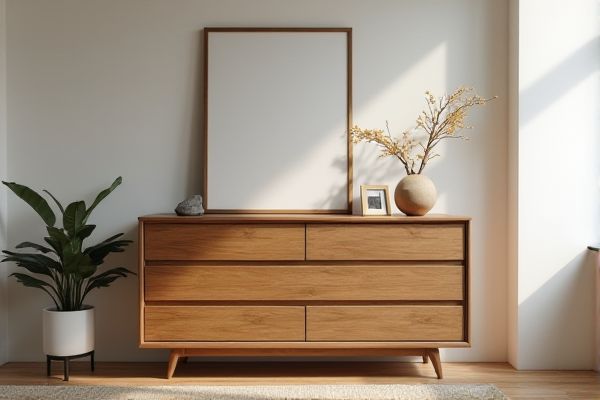
Choosing between a built-in dresser and a stand-alone dresser affects your room's aesthetic and functionality, with built-ins offering seamless integration and stand-alones providing flexibility and mobility. Explore the benefits and downsides of each option to determine which solution best fits your space and style needs. Read on to discover what suits Your home perfectly.
Table of Comparison
| Feature | Built-in Dresser | Stand-alone Dresser |
|---|---|---|
| Installation | Custom-built, requires professional installation | Ready-made, easy to move and install |
| Space Utilization | Optimizes available space, fits walls perfectly | Requires designated floor space, less space-efficient |
| Customization | Highly customizable in size, style, and materials | Limited customization, fixed design options |
| Durability | Usually built with sturdy, long-lasting materials | Varies by brand and material quality |
| Cost | Higher upfront cost due to custom design and installation | Lower cost, more budget-friendly |
| Mobility | Fixed in place, not portable | Portable, easy to relocate |
| Design Integration | Seamlessly integrates with room architecture | Stands as separate furniture, less integrated |
Introduction to Built-in and Stand-alone Dressers
Built-in dressers integrate seamlessly into your room's architecture, offering customized storage solutions that maximize space efficiency and enhance room aesthetics. Stand-alone dressers provide flexible, movable storage options, allowing you to change your room layout easily while choosing from various styles and sizes to match your decor. Selecting between built-in and stand-alone dressers depends on your functional needs, available space, and design preferences for optimal organization.
Key Differences Between Built-in and Stand-alone Dressers
Built-in dressers are integrated into the architecture of a room, offering customized storage solutions that maximize space efficiency and create a seamless look with walls and surrounding furniture. Stand-alone dressers provide flexibility in placement, style, and size, making them easier to move or replace according to changing needs and preferences. The choice between built-in and stand-alone dressers impacts installation complexity, cost, and long-term design coherence within a bedroom or living space.
Space Utilization: Maximizing Bedroom Storage
Built-in dressers optimize bedroom storage by utilizing otherwise unused wall spaces, providing a seamless integration that maximizes vertical and horizontal capacity. Stand-alone dressers offer flexibility in placement but often consume valuable floor space without fully leveraging room dimensions. Choosing built-in designs enhances overall space efficiency, particularly in smaller bedrooms where maximizing storage is crucial.
Aesthetic Appeal and Design Flexibility
Built-in dressers offer seamless integration with your room's architecture, enhancing aesthetic appeal through custom finishes and materials that blend perfectly with existing decor. Stand-alone dressers provide exceptional design flexibility, allowing you to choose from a wide range of styles, sizes, and colors that can be easily repositioned or updated as your taste evolves. Your choice depends on whether you prioritize a cohesive, tailored look or adaptability to changing interior design trends.
Installation and Setup: Ease of Use
Built-in dressers require professional installation involving wall anchoring and custom measurements, which can extend setup time but ensure a seamless fit within the room. Stand-alone dressers offer quick and straightforward assembly or come pre-assembled, allowing immediate use with minimal effort. The ease of setup makes stand-alone dressers ideal for renters or those seeking flexible furniture arrangements.
Cost Comparison: Built-in vs Stand-alone Dressers
Built-in dressers generally involve higher upfront costs due to custom design, materials, and installation fees, while stand-alone dressers offer more budget-friendly options with immediate availability. You can save money with stand-alone dressers by choosing from a wide range of styles and finishes without the need for specialized labor. Over time, built-in dressers may add value to your home by maximizing space and providing a seamless, integrated look that stand-alone units cannot replicate.
Durability and Longevity Considerations
Built-in dressers are typically more durable due to their integration into the wall structure, offering enhanced stability and resistance to wear over time compared to stand-alone dressers. Stand-alone dressers may be vulnerable to damage from movement and everyday use but provide flexibility for relocation and redesign. The choice between built-in and stand-alone dressers significantly impacts long-term investment, with built-ins often requiring initial higher costs but delivering extended lifespan and robust construction.
Customization Options for Each Dresser Type
Built-in dressers offer extensive customization options tailored to fit your room's dimensions and design preferences, including adjustable shelves, integrated lighting, and specific drawer configurations. Stand-alone dressers provide more flexibility in mobility and style variety but come with limited customization beyond paint, hardware, and modular components. Choosing between the two depends on your priority for personalized storage solutions versus versatility in placement.
Pros and Cons of Built-in Dressers
Built-in dressers maximize space efficiency by seamlessly integrating into your room's architecture, offering a sleek, customized look and increased storage capacity without occupying extra floor space. However, their installation can be costly and permanent, limiting flexibility for room rearrangements or future moves while requiring professional design and construction. You benefit most in long-term home customization but may face challenges if your storage needs change or if you prefer adaptability.
Pros and Cons of Stand-alone Dressers
Stand-alone dressers offer flexibility in placement and design, allowing you to easily rearrange or replace them as your style or space needs change. They typically come in a wide range of styles, sizes, and price points, making it easier to find one that fits your budget and aesthetic. However, stand-alone dressers can take up more floor space and may lack the seamless, integrated look of built-in dressers, potentially reducing storage efficiency in smaller rooms.
 homyna.com
homyna.com